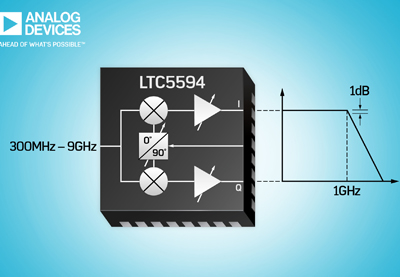Analog Devices has released the LTC5594, a wideband, high linearity, true zero-IF (ZIF) demodulator with 1 GHz instantaneous I and Q bandwidth (measured at 1 dB rolloff).
The demodulator has a typical image rejection of 37 dB. However, using the on-chip serial port, I and Q phase and amplitude imbalance can be corrected — tuned to achieve an image rejection of greater than 60 dB. This feature eases calibration while significantly improving receiver performance and reducing FPGA resources needed to null the residual image.
Using the on-chip serial port, the calibration is easily set. Besides image rejection, the linearity performance including IP2 (second-order intercept), HD2 (second-order harmonic distortion), HD3 (third-order harmonic distortion) and IIP3 can be optimized. The output DC offset voltage can be nulled to allow DC coupling to the ADC for true ZIF operation. Once calibrated at room temperature, these metrics are remarkably stable to the rated temperature range from -40°C to 105°C case.
The LTC5594 has integrated baseband amplifiers with adjustable gain, providing a maximum power conversion gain of 9.2 dB at 5.8 GHz, while achieving 37 dBm output IP3. The RF input has an integrated, wideband balun transformer, allowing single-ended operation with 50 Ω matching from 500 MHz to 9 GHz. The same input can be matched at lower frequencies, from 300 to 500 MHz, by changing one external matching component value.
The high level of integration results in minimum external components and small size. The LTC5594 is offered in a 32-lead, 5 mm x 5 mm plastic QFN package. The demodulator is biased with a single 5 V supply, drawing a nominal 470 mA. The baseband amplifiers can be selectively disabled, so the demodulator can run on 250 mA. An enable pin allows an external controller to shut down the device. When disabled, the device typically draws only 20 μA from the supply.
Samples and production quantities are available now.
The LTC5594 is suited for 5G microwave wireless infrastructure platforms that require 1 GHz or greater bandwidth, with the dynamic range to support high-order modulation and gigabit data rates. The device benefits other applications, such as broadband microwave point-to-point backhaul, high performance GPS systems, satellite communications, aircraft avionics, RF test equipment and radar systems. Its superb linearity and image rejection performance are particularly compelling for digital predistortion (DPD) receivers.


